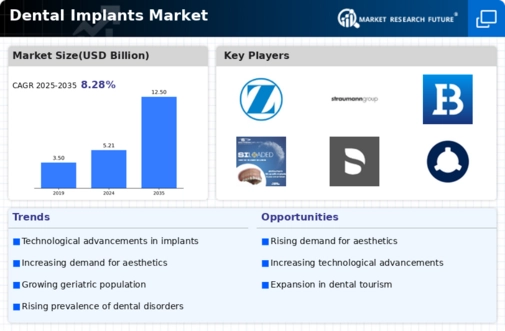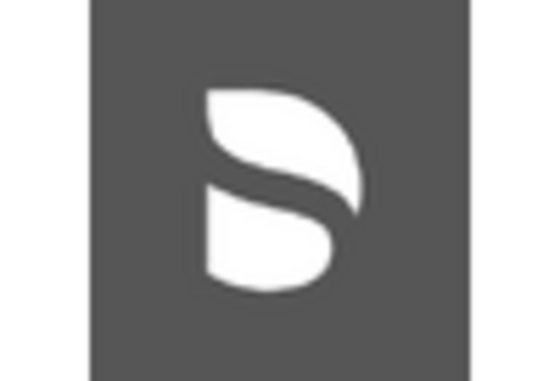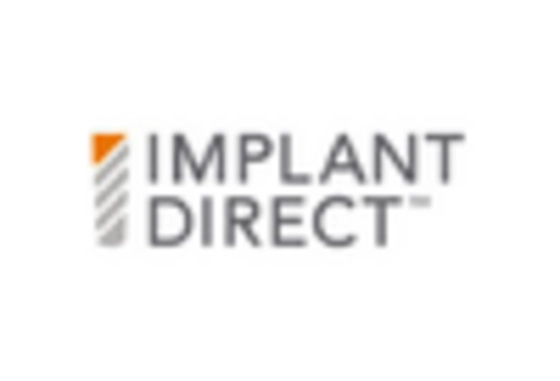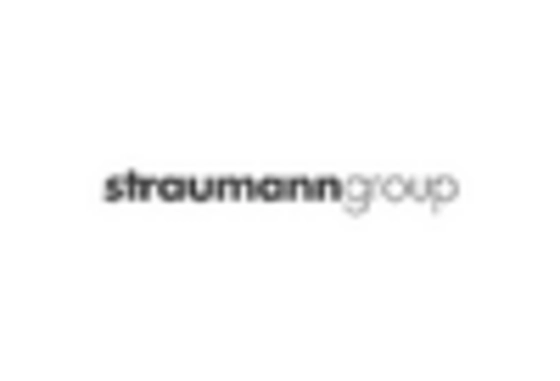Rising Consumer Awareness
Consumer awareness regarding oral health and the benefits of dental implants is on the rise, significantly impacting the Dental Implants Market. As individuals become more informed about the advantages of dental implants over traditional dentures, there is a noticeable increase in demand. Educational campaigns and improved access to information through digital platforms have empowered consumers to make informed decisions about their dental health. This heightened awareness is reflected in market data, which indicates that the demand for dental implants has increased by approximately 10% in recent years. Patients are now more likely to seek out dental implants as a long-term solution for tooth loss, thereby driving growth in the Dental Implants Market. Consequently, dental practitioners are adapting their services to meet this growing demand, further solidifying the market's expansion.
Minimally Invasive Techniques
The trend towards minimally invasive techniques is reshaping the Dental Implants Market. Patients increasingly prefer procedures that involve less discomfort and quicker recovery times. Techniques such as flapless surgery and the use of advanced imaging technologies are gaining traction, allowing for more precise implant placements with reduced trauma to surrounding tissues. This shift not only enhances patient experiences but also contributes to improved clinical outcomes. Market analysis suggests that the adoption of minimally invasive techniques could lead to a reduction in overall treatment costs, making dental implants more accessible to a broader audience. As a result, dental practices that incorporate these techniques may see a competitive advantage in the Dental Implants Market, attracting more patients who prioritize comfort and efficiency.
Increased Investment in Dental Healthcare
Investment in dental healthcare is a crucial factor propelling the Dental Implants Market. Governments and private entities are increasingly recognizing the importance of oral health, leading to enhanced funding for dental services and technologies. This influx of investment is facilitating the development of advanced dental implant solutions and improving access to care for patients. Market data reveals that spending on dental healthcare has risen significantly, with projections indicating continued growth in the coming years. As more resources are allocated to dental health initiatives, the availability of dental implants is likely to increase, making them more accessible to a wider population. This trend not only supports the growth of the Dental Implants Market but also underscores the importance of oral health in overall well-being.
Aging Population and Increased Dental Issues
The aging population is a significant driver of growth in the Dental Implants Market. As individuals age, they often experience a higher incidence of dental issues, including tooth loss and periodontal disease. This demographic shift is leading to an increased demand for dental implants as a viable solution for restoring oral function and aesthetics. Data indicates that the population aged 65 and older is expected to grow substantially, which correlates with a rising need for dental restoration services. Consequently, dental professionals are likely to focus more on implantology to cater to this demographic, thereby expanding the Dental Implants Market. The intersection of an aging population and the growing acceptance of dental implants as a standard treatment option suggests a robust market outlook.
Technological Advancements in Dental Implants
The Dental Implants Market is experiencing a surge in technological advancements that enhance the efficacy and reliability of dental implants. Innovations such as 3D printing and computer-aided design are revolutionizing the way implants are manufactured and fitted. These technologies allow for personalized solutions that cater to individual patient needs, potentially improving success rates. Furthermore, the integration of digital imaging and guided surgery techniques is streamlining the implantation process, reducing recovery times and enhancing patient satisfaction. According to recent data, the market for dental implants is projected to grow at a compound annual growth rate of approximately 7.5% over the next several years, driven largely by these technological innovations. As a result, dental professionals are increasingly adopting these advanced techniques, which may lead to a more competitive landscape within the Dental Implants Market.


















Leave a Comment